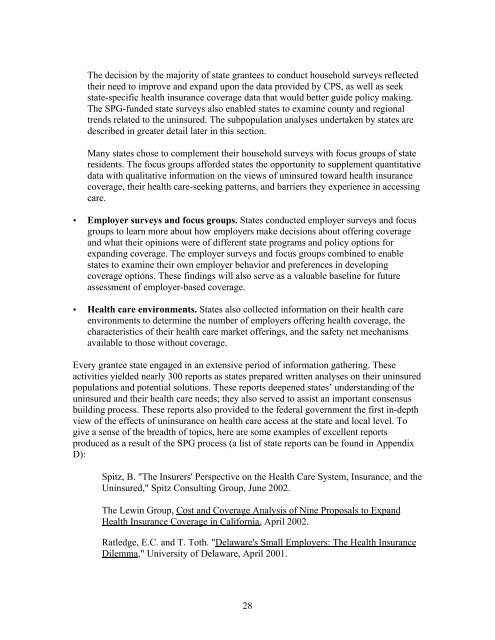SPG synthesis report - State Coverage Initiatives
SPG synthesis report - State Coverage Initiatives
SPG synthesis report - State Coverage Initiatives
You also want an ePaper? Increase the reach of your titles
YUMPU automatically turns print PDFs into web optimized ePapers that Google loves.
The decision by the majority of state grantees to conduct household surveys reflected<br />
their need to improve and expand upon the data provided by CPS, as well as seek<br />
state-specific health insurance coverage data that would better guide policy making.<br />
The <strong>SPG</strong>-funded state surveys also enabled states to examine county and regional<br />
trends related to the uninsured. The subpopulation analyses undertaken by states are<br />
described in greater detail later in this section.<br />
Many states chose to complement their household surveys with focus groups of state<br />
residents. The focus groups afforded states the opportunity to supplement quantitative<br />
data with qualitative information on the views of uninsured toward health insurance<br />
coverage, their health care-seeking patterns, and barriers they experience in accessing<br />
care.<br />
• Employer surveys and focus groups. <strong>State</strong>s conducted employer surveys and focus<br />
groups to learn more about how employers make decisions about offering coverage<br />
and what their opinions were of different state programs and policy options for<br />
expanding coverage. The employer surveys and focus groups combined to enable<br />
states to examine their own employer behavior and preferences in developing<br />
coverage options. These findings will also serve as a valuable baseline for future<br />
assessment of employer-based coverage.<br />
• Health care environments. <strong>State</strong>s also collected information on their health care<br />
environments to determine the number of employers offering health coverage, the<br />
characteristics of their health care market offerings, and the safety net mechanisms<br />
available to those without coverage.<br />
Every grantee state engaged in an extensive period of information gathering. These<br />
activities yielded nearly 300 <strong>report</strong>s as states prepared written analyses on their uninsured<br />
populations and potential solutions. These <strong>report</strong>s deepened states’ understanding of the<br />
uninsured and their health care needs; they also served to assist an important consensus<br />
building process. These <strong>report</strong>s also provided to the federal government the first in-depth<br />
view of the effects of uninsurance on health care access at the state and local level. To<br />
give a sense of the breadth of topics, here are some examples of excellent <strong>report</strong>s<br />
produced as a result of the <strong>SPG</strong> process (a list of state <strong>report</strong>s can be found in Appendix<br />
D):<br />
Spitz, B. "The Insurers' Perspective on the Health Care System, Insurance, and the<br />
Uninsured," Spitz Consulting Group, June 2002.<br />
The Lewin Group, Cost and <strong>Coverage</strong> Analysis of Nine Proposals to Expand<br />
Health Insurance <strong>Coverage</strong> in California, April 2002.<br />
Ratledge, E.C. and T. Toth. "Delaware's Small Employers: The Health Insurance<br />
Dilemma," University of Delaware, April 2001.<br />
28






